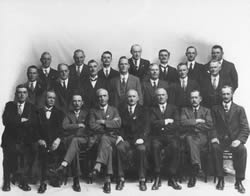Australian Electoral Commission


In 1842, a small group of male residents were enfranchised in New South Wales; however, they were only eligible to elect a proportion of the Colony's Legislative Council.
During the 1850s, people from around the world flocked to the Australian goldfields. They had to purchase licences in order to earn money from prospecting for gold in these fields. In 1854, a miners' protest about the licence fee and their political rights resulted in a rebellion in which both soldiers and miners died. Following the rebellion, a number of the miners' demands were met, including their right to vote.
In 1856, South Australia extended the vote to male residents aged 21 years and over. Two years later, Victoria followed their lead, with the remaining colonies following suit.
Until the 1850s, people voted publicly, which left them vulnerable to intimidation and coercion. To rectify this situation, an independent electoral body was established during the 1850s to ensure elections were run fairly, and to this end the so-called 'Australian ballot', otherwise now known as the secret ballot, was implemented.
During the 1880s, the women's suffragette movement gained momentum. This movement was based on the belief that democracy, in its truest form, could not be achieved until women had the same electoral rights as men. In 1894, the South Australian Parliament agreed and the remaining colonies gradually came to the same view.
Leading by example, Australia helped to pioneer the recognition of women's suffrage internationally.
During the late 19th century, in response to various domestic and international political and economic circumstances, a movement to federate the Australian colonies developed around the country.
In 1898, South Australia, New South Wales, Victoria and Tasmania passed a referendum to federate under an Australian Constitution. The Australian Constitution is the fundamental law explaining how our country is governed, and change to this map of political power requires a referendum. In 1899, Queensland supported the federation, and the following year, Western Australia followed suit.
On 1 January 1901, the nation of Australia was born, with a federal parliament to govern it.
In 1924, to improve the low rates of voter turnout, amendments to the Commonwealth Electoral Act 1918 were made. Compulsory voting was introduced and this resulted in a dramatic increase in voter turnout at the following election.
Aboriginal and Torres Strait Islander peoples campaigned for many years to achieve full voting rights in state and federal elections. These rights were granted federally in 1962, and in 1965 Queensland allowed Aboriginal and Torres Strait Islander people to vote in State elections. Queensland was the last State to grant this right.
During the 1960s and 1970s, a worldwide trend emerged in Western parliamentary democracies supporting lowering of the eligibility age to enrol and vote. Young people paying taxes, driving cars, and serving their country during times of conflict, believed they were entitled to have a say in the composition of their government.
In 1973, the Australian Parliament amended the Commonwealth Electoral Act 1918 and lowered the minimum voting age to 18 years.

In 1902, a branch of the Department of Home Affairs was responsible for Australia's federal electoral system. In 1973, this branch became the Australian Electoral Office. And on 21 February 1984, following major amendments to the Commonwealth Electoral Act 1918, the Australian Electoral Commission (AEC) was established as an independent statutory authority.
The AEC is responsible for conducting federal elections and referendums and maintaining the Commonwealth electoral roll. The AEC also provides a range of electoral information and education services.
The AEC has a national office in Canberra, State Offices in each state capital and a Northern Territory Office in Darwin. Each state is divided into Electoral Divisions, and each division has a Divisional Office Manager who is responsible for electoral administration within their division, in particular, maintaining the electoral roll, and preparing for the next electoral event.
Australia is a federal, representative parliamentary democracy where citizens have the power to elect their representatives in parliament. Enrolling and voting is a right and a responsibility of each Australian citizen.
The effectiveness of our democracy depends on the active participation of all Australian citizens.
How Australian governments deal with the challenges Australia faces as a nation is very much in our hands.